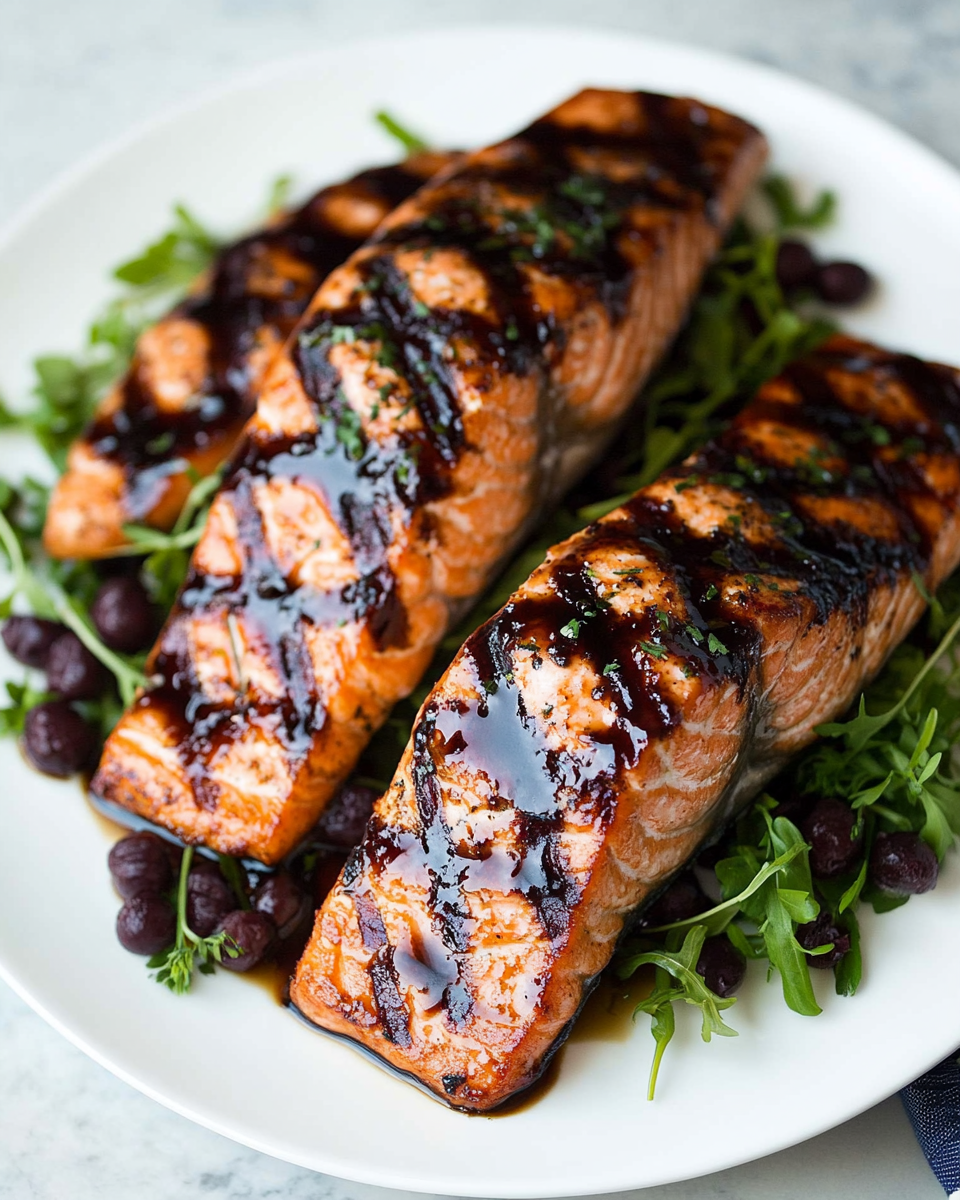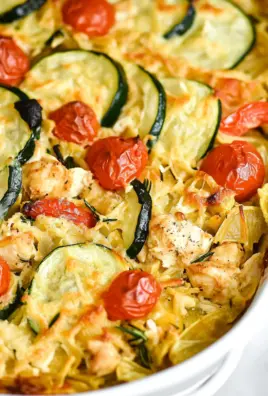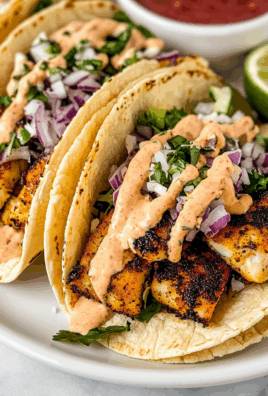If you’re looking for a dish that’s both sophisticated and simple to make, balsamic glazed salmon is the perfect choice. This recipe brings together the rich, buttery texture of salmon with the bold, tangy sweetness of a homemade balsamic reduction. It tastes like something you’d order at a fine restaurant, but comes together in under 30 minutes with ingredients you probably already have in your kitchen.
This dish is perfect for busy weeknights when you want something fast but flavorful, or for entertaining guests without spending hours in the kitchen. It’s healthy, naturally gluten-free, and packed with flavor. The balsamic glaze also doubles as a delicious topping for chicken or vegetables, making this recipe even more versatile.

Preparation Phase & Tools to Use
Before cooking, let your salmon sit at room temperature for about 10–15 minutes. This helps ensure even cooking and prevents the fish from becoming tough. Pat each fillet dry with a paper towel, then season both sides with salt and freshly ground black pepper.
When choosing salmon, go for fresh, high-quality fillets. You can use either skin-on or skinless, but keep in mind that skin-on fillets sear better and retain more moisture during cooking.
Tools You’ll Need
- Non-stick skillet
- Medium saucepan
- Fine mesh strainer
- Fish spatula or a thin metal spatula
Importance of Each Tool
A non-stick skillet ensures the salmon sears beautifully without sticking. The saucepan should be medium-sized and ideally heavy-bottomed to help evenly reduce the glaze without burning. A fine mesh strainer is essential for creating a smooth, glossy glaze by removing rosemary bits and garlic. Finally, a good fish spatula makes flipping the salmon fillets easy and keeps them from falling apart.
Ingredient List
For the Balsamic Rosemary Glaze:
- ½ cup balsamic vinegar
- ¼ cup white wine or low-sodium chicken broth
- 2 tablespoons honey
- 1 tablespoon Dijon mustard
- 1 rosemary sprig (about 7 inches long)
- 1 clove garlic, minced
For the Salmon:
- 4 (6 oz) salmon fillets (skin-on or skinless)
- Salt and freshly ground black pepper, to taste
- 2 teaspoons olive oil
- Finely minced rosemary or parsley for garnish (optional)
Step-by-Step Directions
- Let salmon come to room temperature. Remove the fillets from the fridge and let them sit out for 10–15 minutes.
- Prepare the balsamic glaze. In a medium saucepan, combine balsamic vinegar, white wine or broth, honey, Dijon mustard, rosemary sprig, and minced garlic.
- Bring to a boil. Cook over medium-high heat until boiling.
- Simmer the glaze. Reduce the heat to medium-low and simmer for 10–15 minutes, stirring occasionally, until the mixture reduces to about ⅓ cup and becomes syrupy.
- Strain the glaze. Pour the glaze through a fine mesh strainer into a heatproof bowl. Discard the solids.
- Pat the salmon dry. Use paper towels to remove excess moisture. Season both sides with salt and pepper.
- Sear the salmon. Heat olive oil in a large non-stick skillet over medium-high heat. Place the salmon fillets in the pan, skin-side down if using skin-on. Sear for 3–4 minutes, undisturbed, until golden brown.
- Flip and cook through. Carefully flip the fillets and cook for another 2–3 minutes, or until the salmon is opaque and flakes easily with a fork.
- Plate and glaze. Remove the salmon from the skillet. Drizzle generously with the balsamic reduction. Garnish with fresh herbs if desired.
Tips and Variations
- Make the glaze ahead and store it in the fridge for up to a week.
- Substitute maple syrup for honey for a deeper, earthier sweetness.
- Use chicken or pork instead of salmon—the glaze complements both beautifully.
Balsamic glazed salmon is a dish that checks all the boxes: it’s easy, fast, impressive, and full of flavor. With a few simple tools and ingredients, you can create a meal that feels like a special occasion any night of the week.
Serving Suggestions and How to Perfect Your Balsamic Glazed Salmon
Serving Suggestions
Balsamic glazed salmon is a versatile main course that pairs beautifully with a variety of sides. The tangy-sweet glaze complements both hearty and light accompaniments. Whether you’re serving it for a quick weeknight dinner or a more elegant occasion, here are a few great ways to complete the plate.
Over a Bed of Grains
Serve the salmon over grains like:
- Wild rice – Its nutty flavor balances the sweet glaze.
- Couscous – A light, fluffy option that soaks up the sauce.
- Quinoa – Adds a healthy, protein-packed base.
With Vegetables
The acidity in the glaze contrasts well with earthy or roasted vegetables:
- Grilled asparagus – A classic pairing for salmon.
- Roasted Brussels sprouts – Their crisp edges and slight bitterness work well with the glaze.
- Sauteed spinach – Simple and nutritious.
With Creamy Sides
Balance the bold glaze with something smooth and comforting:
- Garlic mashed potatoes
- Cauliflower puree
- Parmesan risotto
These options round out the dish and make it feel complete.
Common Mistakes to Avoid
While this dish is straightforward, a few common missteps can affect the final result. Here are some things to watch for when making balsamic glazed salmon.
Overcooking the Salmon
Salmon continues to cook slightly after you remove it from heat. Take it off the skillet when it’s just opaque and flakes easily with a fork. Overcooking can make it dry and less flavorful.
Not Patting the Fish Dry
Moisture on the surface of the salmon can prevent proper searing. Always pat the fillets dry with a paper towel before seasoning and searing.
Using Low-Quality Balsamic Vinegar
The glaze is one of the stars of the recipe. Using a cheap or overly acidic vinegar can overpower the dish. Choose a good-quality balsamic vinegar that’s well-balanced and not too sharp.
Cooking with Cold Salmon
Putting cold salmon straight into a hot pan can cause uneven cooking. Letting it rest at room temperature for 10–15 minutes before cooking improves the texture and helps it cook evenly.
How to Perfect the Recipe
Even if you’ve made salmon before, a few extra techniques can take your balsamic glazed salmon from good to great.
Use a Thermometer
If you want precision, aim for an internal temperature of 125°F (52°C) for medium-rare or 130°F (54°C) for medium. This keeps the salmon moist while ensuring it’s fully cooked.
Sear Skin-Side Down First
If you’re using skin-on salmon, always cook skin-side down first. This allows the skin to crisp up and protects the delicate flesh from overcooking.
Don’t Rush the Glaze
Allow the glaze to reduce slowly over medium-low heat. Rushing it on high heat may cause burning or separation. The final glaze should coat the back of a spoon and have a syrup-like consistency.
Add the Glaze at the End
Avoid glazing the salmon while it’s in the skillet. The sugars in the glaze can burn quickly. Instead, cook the fish fully, plate it, and then drizzle the glaze on top.
Recommended Side Dishes
To elevate your balsamic glazed salmon dinner, here are eight flavorful and complementary side dish ideas:
- Garlic Mashed Potatoes – Creamy and savory, they balance the glaze.
- Lemon Roasted Asparagus – Adds brightness and crunch.
- Wild Rice Pilaf – Nutty and earthy, it absorbs the glaze beautifully.
- Crispy Brussels Sprouts – Offers a bold, charred flavor.
- Quinoa Salad with Kale – A light, healthy contrast to the richness of the salmon.
- Cauliflower Mash – Low-carb and smooth, perfect with bold flavors.
- Roasted Butternut Squash – Slightly sweet and comforting.
- Parmesan Risotto – Creamy, savory, and elegant enough for guests.
Each of these sides can complement the deep flavor of the glaze and highlight the tender salmon fillet. Choose based on the occasion and your dietary preferences.
Recipe Tips and Tricks
Balsamic glazed salmon is a dish that rewards attention to detail. While it’s straightforward to make, applying a few expert tips will help elevate the final result every time.
Make the Glaze Ahead of Time
The balsamic glaze can be prepared in advance and stored in the refrigerator for up to five days. This saves time during busy weeknights and ensures the glaze has time to fully develop in flavor.
Adjust the Sweetness
Everyone’s palate is different. If you prefer a glaze that leans less sweet, reduce the amount of honey slightly or add a bit more Dijon mustard for contrast. For a deeper sweetness, a touch of maple syrup works well as a substitute for honey.
Try Other Herbs
While rosemary offers a woodsy depth that pairs beautifully with balsamic, you can experiment with other herbs like thyme or oregano for a slightly different flavor profile. Add fresh herbs only at the end to avoid bitterness.
Use High-Quality Salmon
Look for wild-caught salmon if available. Its richer flavor and firmer texture complement the glaze well. If using frozen salmon, make sure it is fully thawed and patted dry before cooking.
Storage and Reheating Instructions
Balsamic glazed salmon stores well, but it’s best enjoyed fresh. If you have leftovers, here’s how to keep them at their best.
Storing Leftovers
- Let the cooked salmon cool completely.
- Store in an airtight container in the refrigerator.
- Consume within 3 days for best texture and flavor.
Reheating Instructions
- Reheat salmon gently in a skillet over low heat for a few minutes until warmed through.
- Alternatively, place it in a 275°F oven for about 10 minutes.
- Reheat the glaze separately if needed, either on the stovetop or in the microwave at low power to avoid over-thickening.
Avoid microwaving salmon on high, as it can cause the fish to dry out and become rubbery.
Frequently Asked Questions
Can I use frozen salmon?
Yes. Thaw the salmon completely in the refrigerator overnight and pat it dry thoroughly before cooking.
Can I bake the salmon instead of pan-searing it?
Absolutely. Bake at 400°F for 12–15 minutes or until the salmon flakes easily with a fork. Add the glaze just before serving.
Is this dish gluten-free?
Yes. Ensure your Dijon mustard and chicken broth are certified gluten-free.
What type of balsamic vinegar should I use?
Use a good-quality aged balsamic vinegar. Avoid vinegars labeled as “balsamic glaze” since those often contain additional sweeteners and stabilizers.
Can I use another type of fish?
Yes. This glaze works well with trout, cod, or halibut, though cooking times may vary depending on thickness.
Does the glaze store well?
It does. Store it in a sealed container in the fridge for up to five days. Reheat gently before use.
Can I make this dish dairy-free?
This recipe is naturally dairy-free as long as you don’t pair it with creamy or cheese-based side dishes.
Is the glaze overly sweet?
No. It strikes a balance between sweet and tangy. If desired, reduce the honey slightly or increase the mustard for more acidity.
What wine pairs well with this meal?
A dry white wine like Sauvignon Blanc or Pinot Grigio pairs beautifully. For red, try a light Pinot Noir.
Can I freeze this dish?
Freezing is not recommended, as cooked salmon can become dry or lose texture after thawing. Make and serve fresh for best results.
Conclusion
Balsamic glazed salmon is more than just a quick dinner option—it’s a flavorful, elegant dish that suits a variety of occasions. With a perfectly balanced glaze and tender seared salmon, it brings together simplicity and sophistication in one pan. Whether you’re serving it to guests or just looking for a way to make weeknight meals more exciting, this recipe delivers every time. With proper preparation, thoughtful pairings, and a few expert techniques, this dish will quickly become a staple in your kitchen.
Balsamic Glazed Salmon
Ingredients
For the Balsamic Rosemary Glaze:
- ½ cup balsamic vinegar
- ¼ cup white wine or low-sodium chicken broth
- 2 tablespoons honey
- 1 tablespoon Dijon mustard
- 1 rosemary sprig about 7 inches long
- 1 clove garlic minced
For the Salmon:
- 4 6 oz salmon fillets, skinless or skin-on
- Salt and freshly ground black pepper to taste
- 2 teaspoons olive oil
- Finely minced rosemary or parsley for garnish (optional)
Instructions
- Let the salmon fillets sit at room temperature for 10–15 minutes before cooking.
- In a medium saucepan, combine the balsamic vinegar, white wine (or broth), honey, Dijon mustard, rosemary sprig, and minced garlic. Bring to a boil over medium-high heat.
- Reduce heat to medium-low and simmer until the glaze has reduced to about ⅓ cup, about 10–15 minutes. Stir occasionally.
- Strain the glaze through a fine mesh strainer into a heatproof bowl. Set aside.
- Pat the salmon dry and season both sides with salt and pepper.
- Heat olive oil in a large non-stick skillet over medium-high heat. Add the salmon fillets and sear for 3–4 minutes without moving, until browned on the bottom.
- Flip each fillet carefully and cook for another 2–3 minutes, or until the salmon is just cooked through and flakes easily with a fork.
- Serve the salmon warm, drizzled generously with the balsamic glaze. Garnish with minced rosemary or parsley if desired.




Leave a Comment